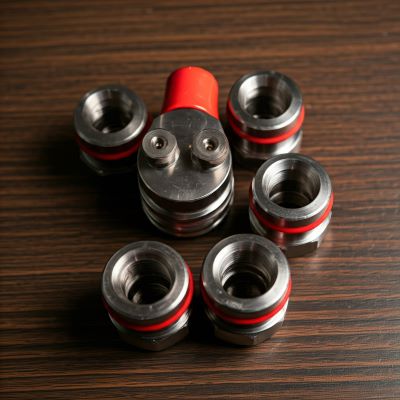Faster couplings are innovative connectors designed to revolutionize the way you connect and disconnect hoses and pipes in fluid and hydraulic systems. By offering quick and easy operation, these couplings significantly reduce downtime, improve efficiency, and enhance overall system performance.
In this guide, we’ll delve into the world of faster couplings, exploring their benefits, applications, and best practices for optimal use.
What Are Faster Couplings?
Faster couplings are specialized connectors designed to streamline the connection and disconnection of hoses and pipes in fluid and hydraulic systems. Unlike traditional couplings, these devices offer quicker and easier operation, minimizing downtime and improving overall system efficiency.
Key Types and Variations of Faster Couplings
Several types of faster couplings are available to suit various industrial applications:
➡️ Camlock Couplings: These couplings feature a cam-locking mechanism that provides a secure and leak-proof connection.
➡️ Ball Lock Couplings: Ball lock couplings use a ball-locking system for quick and easy connection.
➡️ Quick Release Couplings: These couplings offer a simple latching mechanism for rapid connection and disconnection.
The Role of Faster Couplings in Fluid and Hydraulic Systems
Faster couplings are essential in hydraulic and fluid systems because they:
➡️ Reducing downtime: Quick connection and disconnection minimize system downtime during maintenance or operational changes.
➡️ Improving productivity: Faster coupling and uncoupling processes lead to increased productivity and efficiency.
➡️ Enhancing safety: Easy-to-use couplings reduce the risk of accidents and injuries associated with manual connections.
Benefits of Faster Couplings in System Performance
➡️ Increased efficiency: Faster couplings streamline operations, leading to improved overall system performance.
➡️ Reduced labor costs: The ease of use of faster couplings minimizes the time and effort required for connections and disconnections.
➡️ Improved safety: The reduced handling of hoses and pipes lowers the risk of accidents and injuries.
➡️ Enhanced system reliability: Reliable and leak-proof connections ensure optimal system performance.
Materials and Build Quality: How They Impact System Performance
The materials and build quality of faster couplings significantly impact their performance and durability:
➡️ Material selection: Couplings made of high-quality materials like stainless steel or brass offer excellent corrosion resistance and durability.
➡️ Build quality: Precision engineering and robust construction ensure reliable performance under demanding conditions.
Pressure and Temperature Ratings for Optimized Application
It’s essential to select faster couplings with appropriate pressure and temperature ratings to match specific application requirements. Exceeding these limits can lead to leaks, failures, and safety hazards.
Applications of Faster Couplings Across Industries
Faster couplings find applications in various industries, including:
➡️ Construction: For hydraulic equipment, pneumatic tools, and water supply systems.
➡️ Manufacturing: For industrial machinery, process control systems, and lubrication systems.
➡️ Agriculture: For irrigation systems, agricultural machinery, and livestock watering systems.
➡️ Food and Beverage: For cleaning equipment, processing machinery, and beverage dispensing systems.
Maintenance and Replacement Costs: Faster Couplings vs. Others
While faster couplings may have a higher initial cost compared to traditional couplings, they often offer long-term cost savings due to:
➡️ Reduced downtime: Minimized system downtime leads to increased productivity and reduced operational costs.
➡️ Lower labor costs: The ease of use of faster couplings reduces labor costs associated with connections and disconnections.
➡️ Increased equipment lifespan: Reliable connections and reduced wear and tear on hoses and pipes extend equipment life.
Factors to Consider: Material, Size, and Compatibility
When selecting faster couplings, consider the following factors:
➡️ Material: Choose a material compatible with the fluids being handled and the environmental conditions.
➡️ Size: Select the appropriate size to match the hose or pipe diameter.
➡️ Compatibility: Ensure the coupling is compatible with the fittings and components in your system.
Tips for Effective Installation to Maximize Performance
➡️ Cleanliness: Ensure that the coupling and hoses are clean and free of debris before connection.
➡️ Proper alignment: Align the coupling and hose or pipe to ensure a secure and leak-proof connection.
➡️ Tightening: Tighten the coupling according to the manufacturer’s instructions.
➡️ Regular inspection: Periodically inspect the coupling for signs of wear, damage, or leaks.
Troubleshooting Common Issues with Faster Couplings
➡️ Leaking connections: Check for damage to the seals or improper alignment.
➡️ Difficulty in coupling or uncoupling: Clean the coupling and ensure smooth operation of the locking mechanism.
➡️ Excessive wear: Replace worn-out components to maintain optimal performance.
Wrapping Up
Faster couplings offer numerous benefits for fluid and hydraulic systems, including increased efficiency, reduced downtime, and improved safety. By understanding the various types, applications, and maintenance considerations, you can select and utilize faster couplings effectively to enhance system performance and productivity.
Post time: Nov-18-2024


